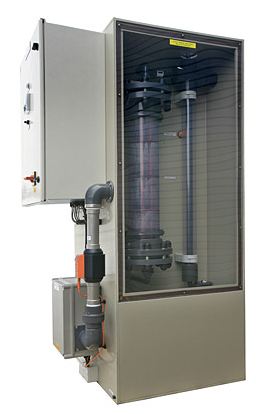The Selcoperm electrolytic chlorination systems produce hypochlorite solution from a solution of common salt using electricity, without creating any notable by-products. The produced hypochlorite solution has a pH value between 8 and 8.5 and a maximum equivalent chlorine concentration of less than 8 g/l. Due to its long half-life it is ideal for storage in a buffer tank. Structure of a Selcoperm system Key components in the Selcoperm unit include an electrolysis system, storage tanks for the saturated salt solution and product solution, an exhaust fan for removing any hydrogen produced, and dosing pumps for the product solution. The concept is rounded off with a measuring and control unit for chlorine dosing. The electrolysis system is supplied as a turn-key solution. Only the pipework for the water supply, the connections of the salt and product storage tanks as well as the exhaust pipe have to be installed. The size of the storage tanks depends on the capacity level of the system and the amount of disinfectant solution required. Benefits Only water, common salt and electricity is needed for the electrolysis – low operating costs, world-wide use. Common salt is non-toxic and easy to store. Fresh hypochlorite is always on hand – the disinfectant solution does not dissociate like commercial hypochlorite solutions. Approved disinfection method complying with the DWI drinking water regulations – an alternative with less safety requirements to chlorine-gas based systems. NSF approval is in process. Robust and elementary components – low-maintenance and a long service life. The systems are a good alternative to chlorine-gas based systems.
Requirements for the installation:
Water:
- Good water quality with low iron (< 200 mg/m3) and manganese (< 50 mg/m3) content, preferably drinking water
- Supply pressure range: from 2.5 to 10 bars. For lower water pressures, booster pumps are available.
- Water inflow temperature must be in the range of 5 °C to 20 °C.
Water Demand:
- 125-150 litres per kg of prepared chlorine
Salt:
- Food-grade common salt (DIN 19604 or EN 973)
- For drinking water disinfection, salt with a low bromide concentration must be used (max. 0.01%)
Salt consumption:
- 3 to 3.5 kg of salt per kg of prepared chlorine
Electrical:
- chlorine Electrical connection 185 to 265 V or 380 to 440 V; 50/60 Hz
Power consumption:
- approx. 4.5-5.5 kWh per kg of prepared chlorine
Drain:
- An on-site drain for the regeneration water of the water softener is necessary.
Exhaust air:
- The outlet of the exhaust air has to be as close as possible to the electrolytic chlorination system.
- In addition, natural air supply via a ventilation hole in the room is required.












